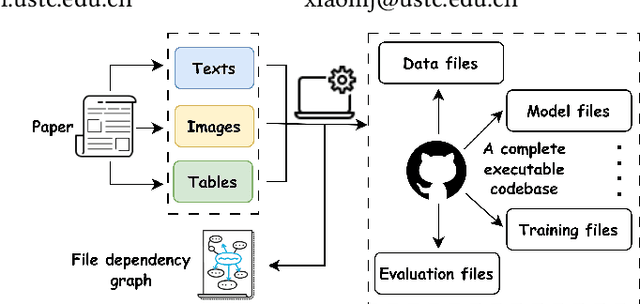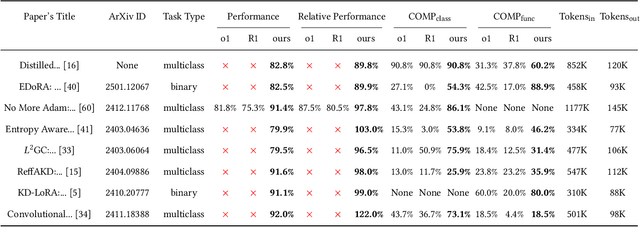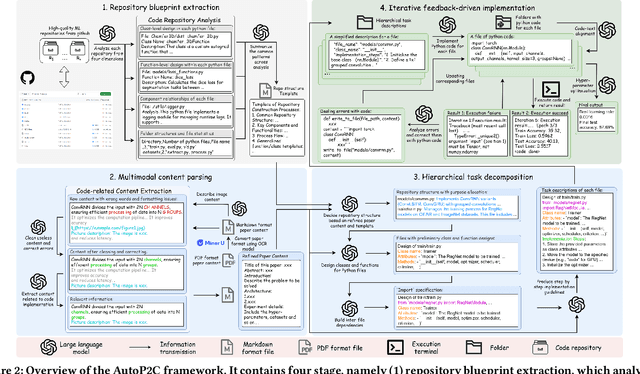Yiqing Shen
Understanding the Implicit User Intention via Reasoning with Large Language Model for Image Editing
Oct 31, 2025Abstract:Existing image editing methods can handle simple editing instructions very well. To deal with complex editing instructions, they often need to jointly fine-tune the large language models (LLMs) and diffusion models (DMs), which involves very high computational complexity and training cost. To address this issue, we propose a new method, called \textbf{C}omplex \textbf{I}mage \textbf{E}diting via \textbf{L}LM \textbf{R}easoning (CIELR), which converts a complex user instruction into a set of simple and explicit editing actions, eliminating the need for jointly fine-tuning the large language models and diffusion models. Specifically, we first construct a structured semantic representation of the input image using foundation models. Then, we introduce an iterative update mechanism that can progressively refine this representation, obtaining a fine-grained visual representation of the image scene. This allows us to perform complex and flexible image editing tasks. Extensive experiments on the SmartEdit Reasoning Scenario Set show that our method surpasses the previous state-of-the-art by 9.955 dB in PSNR, indicating its superior preservation of regions that should remain consistent. Due to the limited number of samples of public datasets of complex image editing with reasoning, we construct a benchmark named CIEBench, containing 86 image samples, together with a metric specifically for reasoning-based image editing. CIELR also outperforms previous methods on this benchmark. The code and dataset are available at \href{https://github.com/Jia-shao/Reasoning-Editing}{https://github.com/Jia-shao/Reasoning-Editing}.
Temporally-Constrained Video Reasoning Segmentation and Automated Benchmark Construction
Jul 22, 2025Abstract:Conventional approaches to video segmentation are confined to predefined object categories and cannot identify out-of-vocabulary objects, let alone objects that are not identified explicitly but only referred to implicitly in complex text queries. This shortcoming limits the utility for video segmentation in complex and variable scenarios, where a closed set of object categories is difficult to define and where users may not know the exact object category that will appear in the video. Such scenarios can arise in operating room video analysis, where different health systems may use different workflows and instrumentation, requiring flexible solutions for video analysis. Reasoning segmentation (RS) now offers promise towards such a solution, enabling natural language text queries as interaction for identifying object to segment. However, existing video RS formulation assume that target objects remain contextually relevant throughout entire video sequences. This assumption is inadequate for real-world scenarios in which objects of interest appear, disappear or change relevance dynamically based on temporal context, such as surgical instruments that become relevant only during specific procedural phases or anatomical structures that gain importance at particular moments during surgery. Our first contribution is the introduction of temporally-constrained video reasoning segmentation, a novel task formulation that requires models to implicitly infer when target objects become contextually relevant based on text queries that incorporate temporal reasoning. Since manual annotation of temporally-constrained video RS datasets would be expensive and limit scalability, our second contribution is an innovative automated benchmark construction method. Finally, we present TCVideoRSBenchmark, a temporally-constrained video RS dataset containing 52 samples using the videos from the MVOR dataset.
Reinforcement Fine-Tuning for Reasoning towards Multi-Step Multi-Source Search in Large Language Models
Jun 10, 2025Abstract:Large language models (LLMs) can face factual limitations when responding to time-sensitive queries about recent events that arise after their knowledge thresholds in the training corpus. Existing search-augmented approaches fall into two categories, each with distinct limitations: multi-agent search frameworks incur substantial computational overhead by separating search planning and response synthesis across multiple LLMs, while single-LLM tool-calling methods restrict themselves to sequential planned, single-query searches from sole search sources. We present Reasoning-Search (R-Search), a single-LLM search framework that unifies multi-step planning, multi-source search execution, and answer synthesis within one coherent inference process. Innovatively, it structure the output into four explicitly defined components, including reasoning steps that guide the search process (<think>), a natural-language directed acyclic graph that represents the search plans with respect to diverse sources (<search>), retrieved results from executing the search plans (<result>), and synthesized final answers (<answer>). To enable effective generation of these structured outputs, we propose a specialized Reinforcement Fine-Tuning (ReFT) method based on GRPO, together with a multi-component reward function that optimizes LLM's answer correctness, structural validity of the generated DAG, and adherence to the defined output format. Experimental evaluation on FinSearchBench-24, SearchExpertBench-25, and seven Q and A benchmarks demonstrates that R-Search outperforms state-of-the-art methods, while achieving substantial efficiency gains through 70% reduction in context token usage and approximately 50% decrease in execution latency. Code is available at https://github.com/wentao0429/Reasoning-search.
Decoupling the Image Perception and Multimodal Reasoning for Reasoning Segmentation with Digital Twin Representations
Jun 09, 2025Abstract:Reasoning Segmentation (RS) is a multimodal vision-text task that requires segmenting objects based on implicit text queries, demanding both precise visual perception and vision-text reasoning capabilities. Current RS approaches rely on fine-tuning vision-language models (VLMs) for both perception and reasoning, but their tokenization of images fundamentally disrupts continuous spatial relationships between objects. We introduce DTwinSeger, a novel RS approach that leverages Digital Twin (DT) representation as an intermediate layer to decouple perception from reasoning. Innovatively, DTwinSeger reformulates RS as a two-stage process, where the first transforms the image into a structured DT representation that preserves spatial relationships and semantic properties and then employs a Large Language Model (LLM) to perform explicit reasoning over this representation to identify target objects. We propose a supervised fine-tuning method specifically for LLM with DT representation, together with a corresponding fine-tuning dataset Seg-DT, to enhance the LLM's reasoning capabilities with DT representations. Experiments show that our method can achieve state-of-the-art performance on two image RS benchmarks and three image referring segmentation benchmarks. It yields that DT representation functions as an effective bridge between vision and text, enabling complex multimodal reasoning tasks to be accomplished solely with an LLM.
Reasoning Segmentation for Images and Videos: A Survey
May 24, 2025Abstract:Reasoning Segmentation (RS) aims to delineate objects based on implicit text queries, the interpretation of which requires reasoning and knowledge integration. Unlike the traditional formulation of segmentation problems that relies on fixed semantic categories or explicit prompting, RS bridges the gap between visual perception and human-like reasoning capabilities, facilitating more intuitive human-AI interaction through natural language. Our work presents the first comprehensive survey of RS for image and video processing, examining 26 state-of-the-art methods together with a review of the corresponding evaluation metrics, as well as 29 datasets and benchmarks. We also explore existing applications of RS across diverse domains and identify their potential extensions. Finally, we identify current research gaps and highlight promising future directions.
Enhancing LLMs' Reasoning-Intensive Multimedia Search Capabilities through Fine-Tuning and Reinforcement Learning
May 24, 2025Abstract:Existing large language models (LLMs) driven search agents typically rely on prompt engineering to decouple the user queries into search plans, limiting their effectiveness in complex scenarios requiring reasoning. Furthermore, they suffer from excessive token consumption due to Python-based search plan representations and inadequate integration of multimedia elements for both input processing and response generation. To address these challenges, we introduce SearchExpert, a training method for LLMs to improve their multimedia search capabilities in response to complex search queries. Firstly, we reformulate the search plan in an efficient natural language representation to reduce token consumption. Then, we propose the supervised fine-tuning for searching (SFTS) to fine-tune LLM to adapt to these representations, together with an automated dataset construction pipeline. Secondly, to improve reasoning-intensive search capabilities, we propose the reinforcement learning from search feedback (RLSF) that takes the search results planned by LLM as the reward signals. Thirdly, we propose a multimedia understanding and generation agent that enables the fine-tuned LLM to process visual input and produce visual output during inference. Finally, we establish an automated benchmark construction pipeline and a human evaluation framework. Our resulting benchmark, SearchExpertBench-25, comprises 200 multiple-choice questions spanning financial and international news scenarios that require reasoning in searching. Experiments demonstrate that SearchExpert outperforms the commercial LLM search method (Perplexity Pro) by 36.60% on the existing FinSearchBench-24 benchmark and 54.54% on our proposed SearchExpertBench-25. Human evaluations further confirm the superior readability.
RBench-V: A Primary Assessment for Visual Reasoning Models with Multi-modal Outputs
May 22, 2025Abstract:The rapid advancement of native multi-modal models and omni-models, exemplified by GPT-4o, Gemini, and o3, with their capability to process and generate content across modalities such as text and images, marks a significant milestone in the evolution of intelligence. Systematic evaluation of their multi-modal output capabilities in visual thinking processes (also known as multi-modal chain of thought, M-CoT) becomes critically important. However, existing benchmarks for evaluating multi-modal models primarily focus on assessing multi-modal inputs and text-only reasoning while neglecting the importance of reasoning through multi-modal outputs. In this paper, we present a benchmark, dubbed RBench-V, designed to assess models' vision-indispensable reasoning abilities. To construct RBench-V, we carefully hand-pick 803 questions covering math, physics, counting, and games. Unlike previous benchmarks that typically specify certain input modalities, RBench-V presents problems centered on multi-modal outputs, which require image manipulation such as generating novel images and constructing auxiliary lines to support the reasoning process. We evaluate numerous open- and closed-source models on RBench-V, including o3, Gemini 2.5 Pro, Qwen2.5-VL, etc. Even the best-performing model, o3, achieves only 25.8% accuracy on RBench-V, far below the human score of 82.3%, highlighting that current models struggle to leverage multi-modal reasoning. Data and code are available at https://evalmodels.github.io/rbenchv
RVTBench: A Benchmark for Visual Reasoning Tasks
May 17, 2025Abstract:Visual reasoning, the capability to interpret visual input in response to implicit text query through multi-step reasoning, remains a challenge for deep learning models due to the lack of relevant benchmarks. Previous work in visual reasoning has primarily focused on reasoning segmentation, where models aim to segment objects based on implicit text queries. This paper introduces reasoning visual tasks (RVTs), a unified formulation that extends beyond traditional video reasoning segmentation to a diverse family of visual language reasoning problems, which can therefore accommodate multiple output formats including bounding boxes, natural language descriptions, and question-answer pairs. Correspondingly, we identify the limitations in current benchmark construction methods that rely solely on large language models (LLMs), which inadequately capture complex spatial-temporal relationships and multi-step reasoning chains in video due to their reliance on token representation, resulting in benchmarks with artificially limited reasoning complexity. To address this limitation, we propose a novel automated RVT benchmark construction pipeline that leverages digital twin (DT) representations as structured intermediaries between perception and the generation of implicit text queries. Based on this method, we construct RVTBench, a RVT benchmark containing 3,896 queries of over 1.2 million tokens across four types of RVT (segmentation, grounding, VQA and summary), three reasoning categories (semantic, spatial, and temporal), and four increasing difficulty levels, derived from 200 video sequences. Finally, we propose RVTagent, an agent framework for RVT that allows for zero-shot generalization across various types of RVT without task-specific fine-tuning.
Position: Foundation Models Need Digital Twin Representations
May 01, 2025Abstract:Current foundation models (FMs) rely on token representations that directly fragment continuous real-world multimodal data into discrete tokens. They limit FMs to learning real-world knowledge and relationships purely through statistical correlation rather than leveraging explicit domain knowledge. Consequently, current FMs struggle with maintaining semantic coherence across modalities, capturing fine-grained spatial-temporal dynamics, and performing causal reasoning. These limitations cannot be overcome by simply scaling up model size or expanding datasets. This position paper argues that the machine learning community should consider digital twin (DT) representations, which are outcome-driven digital representations that serve as building blocks for creating virtual replicas of physical processes, as an alternative to the token representation for building FMs. Finally, we discuss how DT representations can address these challenges by providing physically grounded representations that explicitly encode domain knowledge and preserve the continuous nature of real-world processes.
AutoP2C: An LLM-Based Agent Framework for Code Repository Generation from Multimodal Content in Academic Papers
Apr 28, 2025



Abstract:Machine Learning (ML) research is spread through academic papers featuring rich multimodal content, including text, diagrams, and tabular results. However, translating these multimodal elements into executable code remains a challenging and time-consuming process that requires substantial ML expertise. We introduce ``Paper-to-Code'' (P2C), a novel task that transforms the multimodal content of scientific publications into fully executable code repositories, which extends beyond the existing formulation of code generation that merely converts textual descriptions into isolated code snippets. To automate the P2C process, we propose AutoP2C, a multi-agent framework based on large language models that processes both textual and visual content from research papers to generate complete code repositories. Specifically, AutoP2C contains four stages: (1) repository blueprint extraction from established codebases, (2) multimodal content parsing that integrates information from text, equations, and figures, (3) hierarchical task decomposition for structured code generation, and (4) iterative feedback-driven debugging to ensure functionality and performance. Evaluation on a benchmark of eight research papers demonstrates the effectiveness of AutoP2C, which can successfully generate executable code repositories for all eight papers, while OpenAI-o1 or DeepSeek-R1 can only produce runnable code for one paper. The code is available at https://github.com/shoushouyu/Automated-Paper-to-Code.
 Add to Chrome
Add to Chrome Add to Firefox
Add to Firefox Add to Edge
Add to Edge